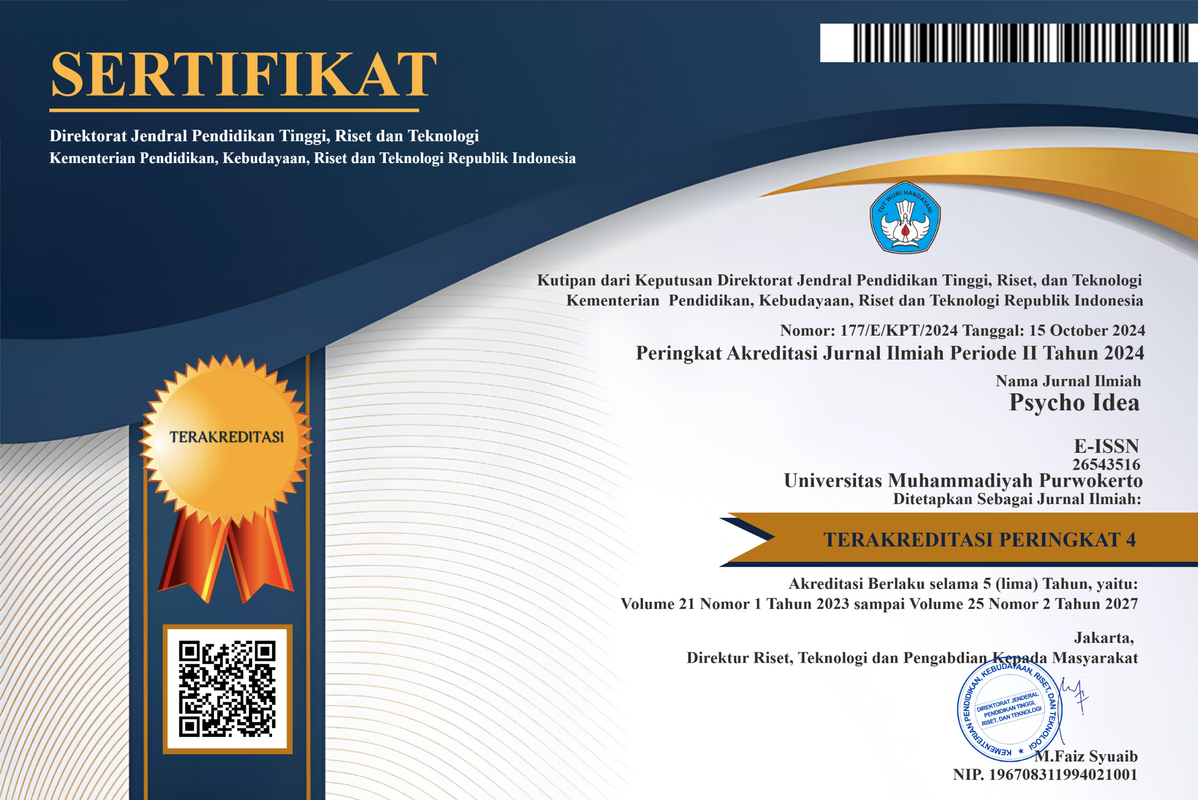HOPE PADAWANITA YANG MENGIKUTI PROGRAM BAYI TABUNG (STUDI PERBEDAAN ANTARA PASIEN BARU DAN PASIEN BERULANG)
DOI:
https://doi.org/10.30595/psychoidea.v16i1.2493Abstract
One of married couple's expectancies is to have offspring. But not all the couples get the offspring due to infertility problems. This infertility problem could be solved by doing in-vitro-fertilization (IVF) programme, but nevertheless the success probability using this IVF method is 50-70%. To support the IVF programme, the patients need physical, mental, financial preparation and hope. Hope becomes one of the supports to make the program successful, because when the patients have hope, the patients also have goal and find alternative ways to make the program successful. Hope is also affected by previous successes, so it's possible to have differences hope between new patients and recurring patients-who have failed in the programme. This research formula is to find out hope differences of new patients and recurring patients. The purpose of this research is to acknowledge hope differences of new patients and recurring patients. Subject of this research is divided between two groups, the new patients and recurring patients. Characteristic of the participant are women, married, don’t have any children or plan to add children, and on going in-vitro fertilization programme.This research method is based on quantitative approach and using purposive sampling.Data collection are taken in Indonesian Reproductive Science Institute by giving Hope Adult Scale that consist 9 items, which represent willpower and waypower. Demographic data are required, consist of age, occupation, education, age of marriage, ethnic and consultation to psychologist. The result of this research shows difference hope between new patients and recurring patients, which recurring patients have greater hope than the new one. The willpower dimension of recurring patients also higher than new patients. It shows that they will to have offspring are bigger than new patients.
Key words : Infertility, IVF Patients, Hope
References
Cathlin, C.A. (2017). Pengaruh hope terhadap resiliensi wanita dewasa muda yang pernah mengalami abortus spontan. (Skripsi tidak dipublikasikan). Fakultas Psikologi, Universitas Pelita Harapan, Karawaci.
Chan, J.C.C., Chan, F., Ditchman, N., Philips, B. & Chou, C.C. (2013). Evaluating snyder’s hope theory as motivational model of participation and life satisfaction for individual with spinal cord injury : A path analysis. Rehabilitation Research, Policy and Education, 27 (3), 172-185.
http://dx.doi.org/10.1891/2168-6653.27.3.171.
Glass, K., Flory, K, Hankin,B.L., & Kloos, B. (2009). Are coping strategies, social support and hope associated with psychological distress among hurricane katrina survivors? Journal of Social and Clinical Psychology, 28(6), 779-795.
Gravetter, F. J., & Forzano L. B. (2011).Research methods for the behavioral sciences. Belmont, CA: Wadsworth Cengage Learning.
Hellman, C.M., Pittman, M.K. & Munoz, R.T. (2013). The first twenty years of the will and the ways : An examination score of reliability distribution on snyder’s dispositional hope scale. Journal of Happiness Studies, 14, 723-729.
http://dx.doi.org/10.1007/s10902-012-9351-5
Luthans, F., Youssef, C.M., & Avolio, B.J. (2007).Psychological capital : Developing the human competitive edge. Oxford : Oxford University Press.
Lopez, S.J., Garigletti, K.P., McDermott,D., Sherwin, E.D., Floyd, R.K., Rand, K & Snyder, C.R. (2000). Hope for the evolution of diversity : On leveling the field of dreams. In Snyder, C.R., Handbook of hope : Theory, measures and application (226-227). California, USA : Academic Press.
Saleh, R. (November 21, 2013). Bayi tabung ke-1000 lahir di klinik morula IVF. Retrieved from http://industri.bisnis.com/read/20131121/103/187865/bayi-tabung-ke-1.000-lahir-di-klinik-morula-ivf
Snyder, C.R. (1994). The psychology of hope. New York : Free Press.
Snyder, C.R. (1995). Conceptualizing, measuring and nurturing hope. Journal of Counseling and Development, 73(3). 355-359.
Snyder, C.R. (2000). The past and possible future of hope. Journal of Social and Clinical Psychology, 19(1), 11-28.
Storck, S. (February 2, 2016). In Vitro Fertilization (IVF) – surgery procedures & risks. The New York Times.Diunduh darihttp://www.nytimes.com/health/guides/surgery/in-vitro-fertilization-ivf/overview.html
Vrischika, N. (2017). Pengaruh hope terhadap resiliensi pada mahasiswa yang mengalami bullying. (Skripsi tidak dipublikasikan). Fakultas Psikologi, Universitas Pelita Harapan, Karawaci.
Wahyuni, T. (December 23, 2015). Empat juta pasangan indonesia mempunyai masalah kesuburan. CNN Indonesia.Diunduh dari https://www.cnnindonesia.com/gaya-hidup/20151223033551-255-99982/empat-juta-pasangan-indonesia-punya-masalah-kesuburan/
Downloads
Published
Issue
Section
License
Authors published in this journal agree to the following terms:
- The copyright of each article is retained by the author (s) without restrictions
- The journal allows the author(s) to retain publishing rights without restrictions
- The author grants the journal the first publication rights with the work simultaneously licensed under the Creative Commons Attribution License, allowing others to share the work with an acknowledgment of authorship and the initial publication in this journal.
- Authors may enter into separate additional contractual agreements for the non-exclusive distribution of published journal versions of the work (for example, posting them to institutional repositories or publishing them in a book), with acknowledgment of their initial publication in this journal
- Authors are permitted and encouraged to post their work online (For example in the Institutional Repository or on their website) before and during the submission process, as this can lead to productive exchanges, as well as earlier and larger citations of published work
- Articles and all related material published are distributed under a Creative Commons Attribution-4.0 International Public License (CC - BY 4.0).
License
Psycho Idea is licensed under a Creative Commons Attribution- 4.0 International Public License (CC - BY 4.0).
You are free to :
Share — copy and redistribute the material in any medium or format
Adapt — remix, transform, and build upon the material for any purpose, even commercially











